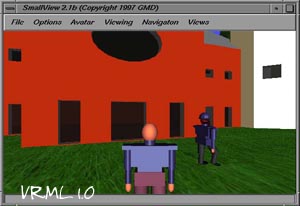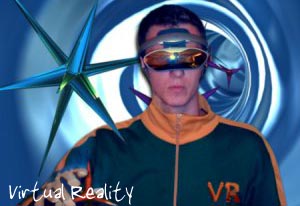









Presently there are numerous different types of VR systems, but most can
be classified into one of the following three categories; Desktop VR,
Video Mapping VR, and Immersive VR.
Desktop
VR (Window on a World) |
Video
Mapping VR |
Immersive
VR |
| Desktop VR is when a computer user views a virtual environment through one or more computer screens. A user can then interact with that environment, but is not immersed in it. All of the mastheads on this website are from Desktop VR environments. | Video Mapping VR uses cameras to project an image of the user into the computer program, thus creating a 2D computer character. Although fully immersed in the environment, it is difficult to interact with the user’s surroundings. | Immersive VR uses a HMD to project video directly in front of the user’s eyes, plays audio directly into the user’s ears, and can track the whereabouts of the user’s head. Then a dataglove (or datasuit) is used to track movements of the user’s body and then duplicate them in the virtual environment. When the user cannot distinguish between what is real and what is not, then immersive VR has succeeded. |
To run the most basic VR system one must have the following:
|
 |
The computer must be powerful enough to render three-dimensional images in real-time or the experience will not be a complete one.
 |
By using various sensors and input devices users can use their own movement to interact with the virtual environment. Each time the sensor detects a change, the entire computer system (the reality engine) generates a new set of graphics, appropriate to that change. For a system to be recognizably ‘real’ the computer must be able to ‘sample’ the sensors about sixty times per second. This gives real-time changes (apparently instantaneous, but really with the shortest time lag possible). (Sherman and Judkins 1992) |
Computers this fast do not exist at the present time, but with the power of computers doubling every 18 months, it may be possible in the near future. (Stevens 1994)
This site was published for Communication Studies 380 at the University of Calgary, March 26, 2004
